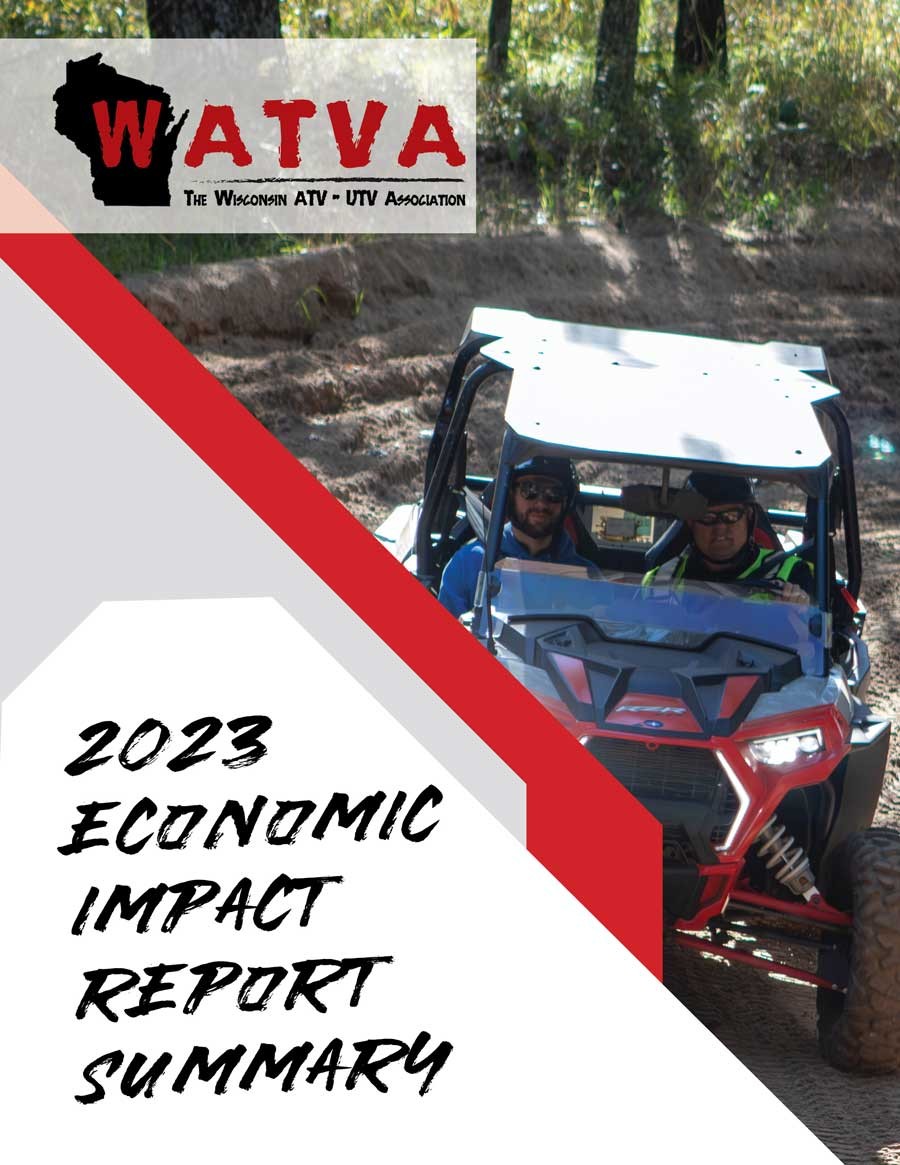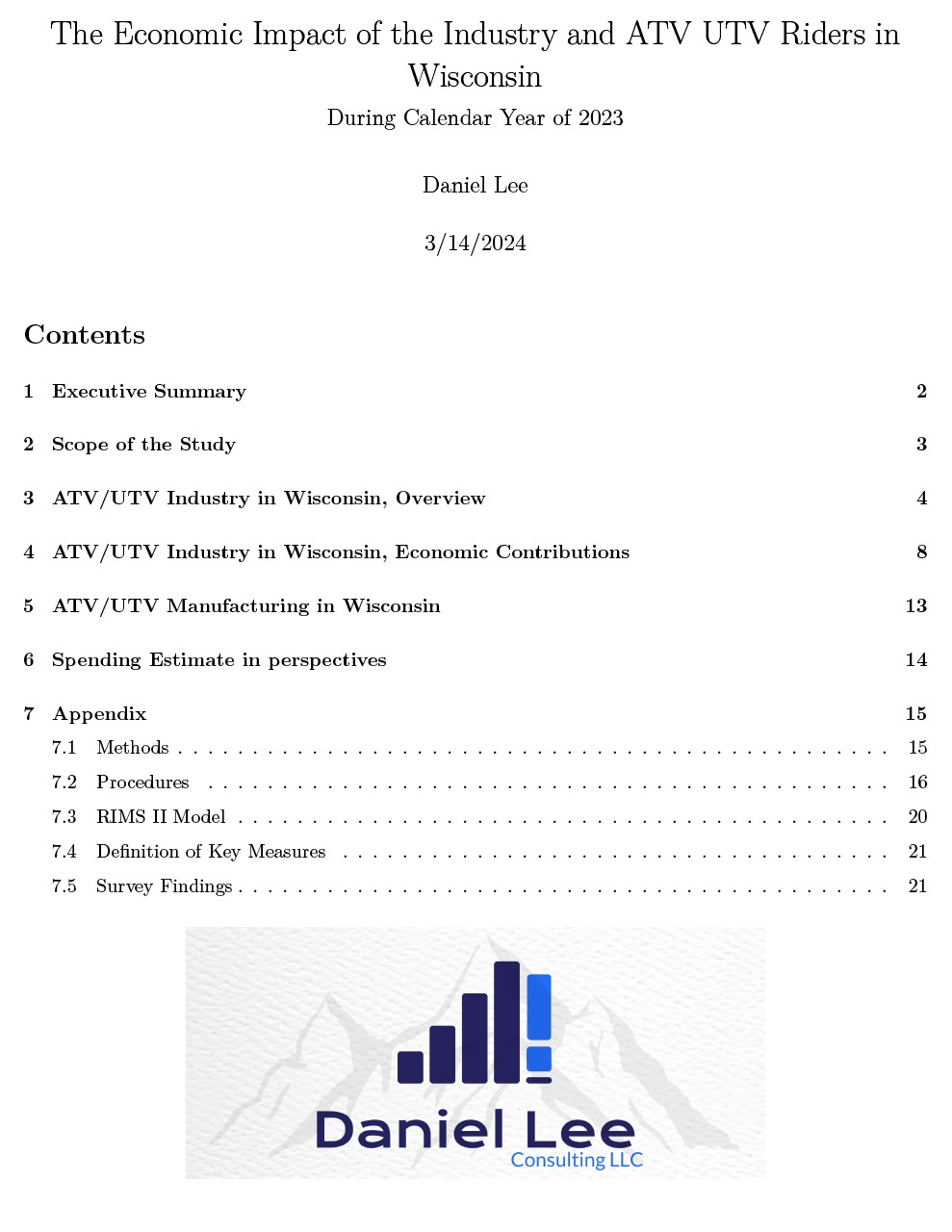Economic Data for ATVs & UTVs
The following are economic impact studies that have been conducted to showcase the economic benefits ATVs and UTVs are towards a community.
The Economic Impact of ATV / UTV Riders in Wisconsin (2023)
The Wisconsin ATV / UTV Association's rider-funded economic impact survey of riders during 2023. Data was gathered statewide by our volunteers and complied and reviewed by Daniel Lee Consulting LLC.
2024 Economic Report Summary
The Economic Impact of ATV / UTV Riders in Wisconsin
Comprehensive data on ATV/UTV rider spending was collected through an on-site, in-person survey conducted and funded by the NOHVIS Group in partnership of the Wisconsin ATV Association. Participants were asked to provide detailed spending information by category, offering insights into their economic contributions. While the survey excludes activity by minors, it includes spending made by adults on their behalf, providing a holistic view of economic impacts. Additionally, survey respondents comprise both in-state and out-of-state residents.
Furthermore, this study utilizes the RIMS II input/output economic model by the United States Bureau of Economic Analysis to measure multiplier effects of ATV/UTV rider spending. Through this model, the estimated economic value was expressed by metrics such as employment, labor income, and output in Wisconsin. Moreover, the author estimated state and local government taxes using RIMS II impact results and government tax data. Together, these methodologies offer a comprehensive understanding of the economic implications of ATVing activity in Wisconsin.
Jackson County ATV/UTV Trail Study Survey Report, 2019 (June 2020/11)
The purpose of this study was to obtain trail surface preferences of ATV and UTV users of the Jackson County trail network and to solicit feedback about their trail experiences.
Jackson County ATV Trail Users Survey Report (2015)
The purpose of this study was to assess the economic impact of users of the Jackson County trail network and to solicit feedback from riders about their experience. Survey data were collected by intercept interviews with trail users during the 2015 trail season (May 16 to October 15).
Outdoor Recreation Satellite Account: Prototype Statistics for 2012-2016
Published by: The Bureau of Economic Analysis, U.S. Department of Commerce
Prototype statistics from the Outdoor Recreation Satellite Account (ORSA) released by the U.S. Department of Commerce's Bureau of Economic Analysis (BEA) show that the outdoor recreation economy accounted for 2.0 percent ($373.7 billion) of current-dollar GDP in 2016 (table 1). In addition, the outdoor recreation economy grew 3.8 percent in 2016, compared to growth of 2.8 percent in the overall economy.
A Case Study of Cheese Country Trail Users & Economic Impacts in Southwestern Wisconsin (2012)
Published by: University of Wisconsin – Madison/Extension, Department of Urban and Regional Planning
Motorized trail use is an important activity throughout the Lake States and is an important component of outdoor recreation in Wisconsin. As an enjoyable activity for all ages, it represents a particularly important form of outdoor recreation for older adults. The presence of places to ride and trails that connect communities provides these recreationists with a varied and enjoyable landscape within which to enjoy the Wisconsin outdoors. Motorized use trails also provide important assets for the development of tourism within rural communities.
In this report, we raise issues relevant to motorized recreational use of trails and the communities that find themselves affected by these trail users. We do this from a community development context and focus on the developmental attributes of trail user impacts as an externally driven community economic stimulus. As evidence, we support this with case study research of the Cheese Country Trail in Green, Lafayette, and Iowa Counties of southwestern Wisconsin.
Economic & Demographic Profile of Wisconsin's ATV Users (2004) (Updated 2022 Projections)
Published by: Department of Urban & Regional Planning, University of Wisconsin-Madison/Extension
In an attempt to gather more information about Wisconsin's ATV riders, the Department of Tourism partnered with the Wisconsin All-Terrain Vehicle Association (WATVA) and the University of Wisconsinís Department of Urban and Regional Planning to gather marketing and economic impact information. The objectives of the research were: 1) to define an ATV rider (age, educational level, and residence); 2) to describe characteristics of the ATV trip (length of overnight stays, overnight accommodations, and party size), 3) to identify the userís reasons for being in the area and other attractions/activities they will participate in while on this trip; 4) to assess the importance of various aspects of ATV trail riding; 5) to measure user expenditures in the area; and 6) to determine the economic impact of nonresident visitors in the area.
Using the data from the 2003/4 study, we updated the number for current registrations and inflation. Click the file below to download. There is also a video explaining the then to now economic update.
Data: Motorcycling, ATV riding, side-by-side driving among nation's largest outdoor recreation activities
IRVINE, Calif., — Motorcycling, ATV riding, and side-by-side driving are among the country's five largest traditional or conventional outdoor recreation activities, when ranked by economic output, according to data released last week by the U.S. Bureau of Economic Analysis.
This was the first time that the BEA provided preliminary data on economic contribution in all 50 states and the District of Columbia, demonstrating how important outdoor recreation is to both local business as well as the nation's gross domestic product.
And, it's a growth sector.
According to the BEA release, its Outdoor Recreation Satellite Account "shows that inflation-adjusted (real) GDP for the outdoor recreation economy grew by 3.9 percent in 2017, faster than the 2.4 percent growth of the overall U.S. economy. Real gross output, compensation, and employment all grew faster in outdoor recreation than for the economy as a whole."
The bureau defines "conventional" outdoor recreation as activities done for pleasure, such as camping, hiking, hunting, and fishing, and involving some physical effort.
| Sport | Economic Output |
| Boating / Fishing | $20.9 billion |
| RVing | $16.9 billion |
| Motorcycling / ATVing / SxS | $9.1 billion |
| Hunting / Shooting / Trapping | $8.8 billion |
| Equestrian | $7.8 billion |
"We have long known that motorcycling, ATV riding and side-by-side driving are major contributors to the economy, to our country's GDP, in so many ways," said Tim Buche, president and CEO of the Motorcycle Industry Council. "We boost local economies, too, and not just through powersports dealers and retailers. Our enthusiasts book hotel stays, pay park fees, buy food, supplies, and other gear they need for all sorts of great outdoor adventures. All of that makes them, and our industry, a powerful economic engine that merits the attention of policymakers and those who manage public lands."
The Outdoor Recreation Roundtable is a coalition of outdoor recreation trade associations and the Motorcycle Industry Council, the Specialty Vehicle Institute of America and the Recreational Off-Highway Vehicle Association are members. Looking at the BEA's latest report, the ORR noted some additional highlights:
Outdoor recreation accounts for 2.2 percent of U.S. GDP, creating $778 billion in gross output supporting 5.2 million jobs.
Outdoor recreation is responsible for a larger share of GDP than many major industries, including chemical products manufacturing, farming and ranching, mining, and utilities.
"[The] release of state data is a significant step forward for the entire outdoor recreation industry," said Jessica Wahl, executive director of the Outdoor Recreation Roundtable. "This second full year of national data—together with prototype state-level numbers—proves that our industry is a driving economic force across the country. ORR will continue to work with Congress, federal agencies, state governments and others to ensure that everyone has access to our public lands and waters and that our nation's outdoor infrastructure can sustain and grow healthy communities and healthy economies."
The Motorcycle Industry Council exists to preserve, protect and promote motorcycling through government relations, communications and media relations, statistics and research, aftermarket programs, development of data communications standards, and activities surrounding technical and regulatory issues. As a not-for-profit national industry association, the MIC seeks to support motorcyclists by representing manufacturers, distributors, dealers and retailers of motorcycles, scooters, ATVs, ROVs, motorcycle/ATV/ROV parts, accessories and related goods and services, and members of allied trades such as insurance, finance and investment companies, media companies and consultants.
The MIC is headquartered in Irvine, Calif., with a government relations office in metropolitan Washington, D.C. First called the MIC in 1970, the organization has been in operation since 1914. Visit the MIC at mic.org.
The Specialty Vehicle Institute of America is the not-for-profit national industry association promoting the safe and responsible use of all-terrain vehicles through rider training, public awareness campaigns, and state legislation. Additionally, SVIA works to preserve access to off-road riding areas and expand riding opportunities. Accredited by the American National Standards Institute, SVIA develops standards for the equipment, configuration, and performance requirements of ATVs. Based in Irvine, Calif., SVIA is sponsored by American Honda Motor Co., Inc.; BRP, Inc.; Kawasaki Motors Corp., U.S.A.; KYMCO USA, Inc.; Polaris Industries Inc.; Suzuki Motor of America, Inc.; Arctic Cat; and Yamaha Motor Corporation, U.S.A. Visit SVIA online at svia.org. For safety information or to enroll in the ATV RiderCourse nearest you, visit atvsafety.org, or call (800) 887-2887.
The Recreational Off-Highway Vehicle Association is the not-for-profit national industry association promoting the safe and responsible use of ROVs (also called side-by-sides or UTVs). Accredited by the American National Standards Institute (ANSI), ROHVA develops standards for the equipment, configuration, and performance requirements of ROVs.
Based in Irvine, Calif., ROHVA is sponsored by American Honda Motor Co., Inc.; BRP, Inc.; Kawasaki Motors Corp., U.S.A.; Mahindra North America; Polaris Industries Inc.; Arctic Cat; and Yamaha Motor Corporation, U.S.A.. For more information visit rohva.org.
The Outdoor Recreation Roundtable is America's premier coalition of outdoor recreation trade associations, made up of 28 members representing over 50,000 American businesses. These organizations represent a sector of the economy that produces $778 billion in economic output, accounts for 2.2 percent of U.S. GDP and supports 5.2 million jobs—all while growing faster than the nation's economy as a whole.
When you subscribe to the blog, we will send you an e-mail when there are new updates on the site so you wouldn't miss them.


